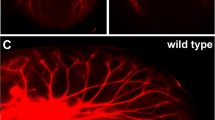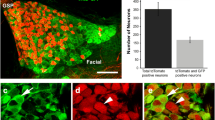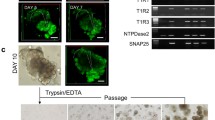Abstract
The development and innervation of vallate papillae and taste buds in mice were studied using antibodies against the neuronal marker, protein gene product 9.5 (PGP 9.5), and against nerve growth factor (NGF) and brain-derived neurotrophic factor (BDNF). PGP 9.5 immunohistochemical studies revealed that the earliest sign of median vallate papilla formation was an epithelial bulge at embryonic day 13 (E13), and at E14, a dense nerve plexus was found within the connective tissue core of the papilla. Thin nerve fibers penetrated the apical and medial trench wall epithelium of the papilla at E16 and a few of these began to invade the lateral trench wall epithelium at E17. At postnatal day 1 (P1), the newly formed taste buds were recognizable and a small number of PGP 9.5-immunoreactive (IR) cells appeared on the medial trench wall epithelium. The number of PGP 9.5-IR taste bud cells then increased gradually and reached the adult level at postnatal week 2. PGP 9.5 immunoreactivity increased systematically with age. NGF and BDNF immunoreactivity was first seen at the boundary between the columnar cells in the apical epithelium of the developing vallate papilla at E13, then in the medial and lateral trench walls at E15 (BDNF) or E18 (NGF). At P1, BDNF immunoreactivity was exclusively present in the newly formed taste buds of the medial trench wall. The number of BDNF-IR taste bud cells then increased gradually, reaching the adult level at P7. Similar degrees of NGF and BDNF immunoreactivity were seen in the developing vallate papilla. In the present study, we found that the vallate papilla was formed prior to its innervation, and we propose that initiation of papilla formation does not require any direct influence from the specific gustatory nerve. We also suggest that neurotrophins in the early developing vallate papillae might act as local tropic factors for the embryonic growth of nerve fibers to induce differentiation of the taste buds.
Similar content being viewed by others
Author information
Authors and Affiliations
Additional information
Accepted: 26 April 2001
Rights and permissions
About this article
Cite this article
Chou, HC., Chien, CL. & Lu, KS. The distribution of PGP9.5, BDNF and NGF in the vallate papilla of adult and developing mice. Anat Embryol 204, 161–169 (2001). https://doi.org/10.1007/s004290100190
Issue Date:
DOI: https://doi.org/10.1007/s004290100190




